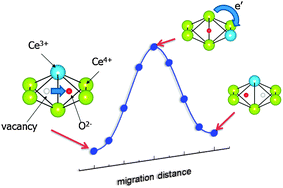A concerted migration mechanism of mixed oxide ion and electron conduction in reduced ceria studied by first-principles density functional theory
Abstract
Ceria based

* Corresponding authors
a
Department of Materials Science and Engineering, Nagoya Institute of Technology, Room 604A, Bldg. 2, Gokiso-cho, Showa-ku, Nagoya City, Aichi, Japan
E-mail:
nakayama.masanobu@nitech.ac.jp
Fax: +81-52-735-5189
Tel: +81-52-735-5189
b Institute of Physical Chemistry, RWTH Aachen University, Landoltweg 2, 52056 Aachen, Germany
Ceria based

 Please wait while we load your content...
Something went wrong. Try again?
Please wait while we load your content...
Something went wrong. Try again?
M. Nakayama, H. Ohshima, M. Nogami and M. Martin, Phys. Chem. Chem. Phys., 2012, 14, 6079 DOI: 10.1039/C2CP00020B
To request permission to reproduce material from this article, please go to the Copyright Clearance Center request page.
If you are an author contributing to an RSC publication, you do not need to request permission provided correct acknowledgement is given.
If you are the author of this article, you do not need to request permission to reproduce figures and diagrams provided correct acknowledgement is given. If you want to reproduce the whole article in a third-party publication (excluding your thesis/dissertation for which permission is not required) please go to the Copyright Clearance Center request page.
Read more about how to correctly acknowledge RSC content.
 Fetching data from CrossRef.
Fetching data from CrossRef.
This may take some time to load.
Loading related content
